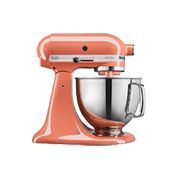Ceramic Cutlery Use and Care
KitchenAid Ceramic Cutlery Use and Care
Ceramic knives maintain sharpness longer than steel knives and are lightweight and rust-resistant. They also won’t transfer smells or tastes while cutting different foods, making them great for meal prep. Rinse the blade with water after chopping garlic or spices, and the flavor won’t mix with the next food you cut. Acidic foods won’t damage ceramic blades, so they are perfect for cutting oranges, tomatoes, and other soft fruits and vegetables. These essential knives are a great addition to any kitchen, and it is important to properly use and care for them so they continue to deliver excellent results.
Using Your Cutlery
Proper Use
Choosing the right knife will help you accomplish tasks more efficiently, cut correctly, and can improve the texture of your food by preventing bruising of fruits and vegetables and tearing of meats. Refer to the following when choosing a knife:
- Chef Knife: The chef knife is excellent for chopping, mincing, and slicing vegetables and meat.
- Slicing Knife: The slicing knife is great for carving roasts, turkey, ham, or other cooked meats into serving portions, and can also be used for chopping, mincing, or slicing vegetables.
- Bread Knife: The bread knife easily cuts through soft-crusted bread and pastries and is also great for pineapples, melons, or other citrus fruits with thick skin or rind.
- Santoku Knife: This multipurpose knife minces, dices, and slices small vegetables.
- Utility Knife: This multi-use knife is great for cutting sandwiches, slicing smaller cuts of meat, and cutting larger fruits.
- Serrated Utility Knife: The serrated utility knife is perfect for slicing fruits, vegetables, smaller breads, and more. It is especially effective for tomatoes, salami, croissants, or small foods with a hard crust or skin.
- Paring Knife: This knife is handy for smaller precision tasks like peeling, trimming, and slicing small fruits and vegetables.
- Kitchen Shears: These are great for multiple uses around the home. They can be used to cut up meat, remove thyme leaves, snip through bread or pizza, and perform many other kitchen tasks.
- Cleaver: The cleaver is designed to easily carve through tough or tender meat and dense vegetables with one downward stroke.
- Serrated Paring Knife: The serrated paring knife is ideal for small, everyday food-prep needs, from cutting delicate fruit to slicing up a snack.
- Steak Knife: Steak knives are designed to cut a variety of cooked meats easily.
Avoiding Damage
Ceramic blades are not intended for use with frozen foods, large, hard-skinned fruits, and vegetables such as watermelon or spaghetti squash, hard cheeses, or meat and poultry with bones.
Do not use knives as screwdrivers or can openers; this could damage the blade. Do not drop or hit the knife on hard surfaces. Do not use it for prying, twisting, or applying force to the side of the blade board.
Cutting Surfaces
Use smooth, easy-to-clean cutting surfaces such as wood, polypropylene, or polyethylene cutting boards. Do not use knives on hard surfaces that can dull or damage the cutting edge, such as glass, stone, ceramic, metal, or countertops.
Cleaning Cutlery
Ceramic cutlery is guaranteed to be dishwasher-safe, rust-free, and corrosion-free for the lifetime of the product.
Sharpening Cutlery
KitchenAid® ceramic knives should not require regular sharpening due to their stay-sharp properties; however, they must be professionally sharpened as necessary to avoid chipping the blade.
If you would like to download or view product literature for your appliance, please visit our Manuals and Literature page.










.png)

























